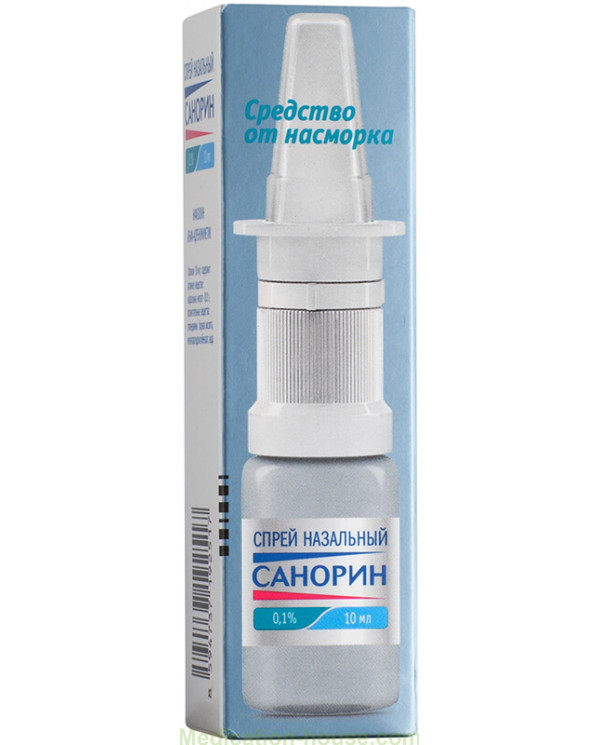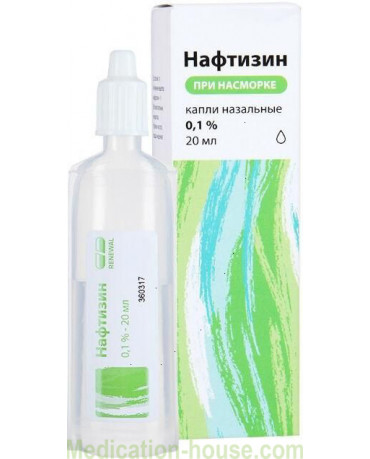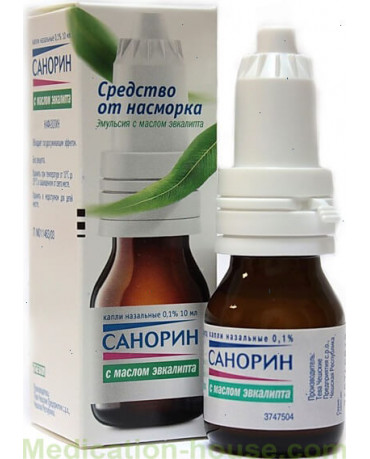Sanorin spray user manual
You can buy spray Sanorin here
Release form and medicinal composition
Topical anticongestant is available in two dosage forms:
nasal drops a clear solution in a dark glass vial with a capacity of 10 ml, which is equipped with a pipette cap (contains 0.05% or 0.1% of active ingredients);
nasal spray is a clear solution in a bottle of matte plastic with a capacity of 10 ml, which is equipped with a metering applicator (contains 0.1% of active ingredients).
The following components are included in 1 ml of medicinal fluid:
naphazoline nitrate;
preservative E218;
1,2-diaminoethane;
purified water;
orthoboric acid;
p-hydroxybenzoic acid methyl ester.
In a white-blue box contains 1 bottle with Sanorin and the official instructions for use.
Pharmacological properties
Naphazoline nitrate alpha-adrenergic agonist, which has anti-congestive and vasoconstrictive effects. It stimulates the activity of alpha-adrenergic receptors, as a result of which there is a narrowing of the blood capillaries in the nasal mucosa. It has a moderate antiflogistic effect, therefore, with intranasal use, it quickly eliminates hyperemia and inflamed tissues.
According to patient reviews, with local application of sympathomimetic on the surface of the nasal passages, the vasoconstrictor effect is manifested within 4-7 minutes. With a cold, it facilitates breathing through the nose by reducing the outflow of intercellular fluid through the vascular walls into the surrounding tissue.
Pharmacokinetic properties
In the case of parenteral administration of naphazoline, nitrate is absorbed into the general bloodstream. The active ingredients quickly penetrate into the lacrimal glands, but do not cross the blood-brain barrier. Prolonged use of anticongestant is accompanied by the development of tolerance and rebound syndrome. In this regard, nasal drops and spray are not recommended for more than 1 week in a row.
Indications for use
An anti-congestive agent is used as part of palliative therapy of inflammatory processes in the nasopharynx caused by allergic reactions or pathogens. According to the instructions, indications for the appointment of a rhinological drug are:
rhinorrhea;
laryngitis;
acute rhinitis;
salpingo-otitis;
hyperemia of the nasal mucosa;
chronic conjunctivitis;
inflammation syndrome of the nasopharynx;
seasonal allergic rhinoconjunctivitis;
inflammation of the sinus mucosa (sinusitis).
Sympathomimetic is often used in combination with locally anesthetic medicines during diagnostic and physiotherapeutic procedures: rhinoscopy, sanitation of the paranasal sinuses according to Senderman, irrigation of the nasal cavity, method of moving the fluid along the Proetz, etc.
Dosage regimen
The rhinological medication is intended for intranasal use. When treating children under 6 years of age, the spray is not used, because it can cause bronchospasm and complications in the form of tubo-otitis and otitis media. The dosage of sympathomimetic depends on the age of the patient:
children 2-12 years old, 1-2 drops (or 1-2 doses when using a spray) of a 0.05% solution no more than 3 times a day;
adolescents and adults 2-3 drops (or 2-3 doses when using a spray) of 0.1% solution no more than 4 times a day.
Children under 12 years old can use alpha-adrenergic agonist no more than 3, and adults no more than 7 days in a row. In the absence of the desired effect, it is necessary to replace Sanorin with other nasal agents that do not contain naphazoline nitrate.
In case of nosebleeds, it is allowed to put cotton turundas soaked in a 0.05% vasoconstrictor solution into the nasal passages. Before conducting a hardware diagnosis, 3-4 drops of Sanorin are instilled into the nose in combination with 1 ml of anesthetic.
Gestation and lactation
When prescribing decongestant during pregnancy and lactation, all possible risks for the fetus and mother should be considered, because it is not known whether naphazoline nitrate can cross histohematological barriers.
Alcohol compatibility
The instructions do not contain information on the significant interaction of ethanol with naphazoline nitrate and the occurrence of adverse reactions with the parallel use of alcoholic beverages.
special instructions
The use of Sanorin in patients with severe heart failure should be monitored by a physician. In case of an overdose, an alpha-adrenergic agonist can cause systemic complications in people suffering from such diseases:
diabetes;
hormone-active tumor;
arterial hypertension;
angina pectoris;
hyperactivity of the thyroid gland.
With extreme caution, it is necessary to use a rhinological preparation in combination with anesthetics, which increase the sensitivity of myocardial tissue to alpha-adrenergic agonists. It is undesirable to abuse vasoconstrictor drops in bronchial asthma and impaired conduction of the heart.
If Sanorin is used in recommended doses, the kidneys and liver do not experience a strong toxic load. Therefore, with moderate impairment of the functions of these organs, the dosage is not changed.
Drug Interactions
An anti-congestive agent prevents the absorption of locally analgesic drugs into the systemic circulation, which should be considered when performing surgical operations and hardware diagnostics. Maprotiline and tricyclics potentiate the vasoconstrictive effect of drops and spray, which can subsequently lead to an increase in blood pressure. Naphazoline nitrate is incompatible with monoamine oxidase inhibitors due to possible systemic vasoconstriction.
Overdose
An overdose or mistaken ingestion of an alpha-adrenergic agonist may be accompanied by such effects:
hand tremor;
cyanosis of the lips and oral mucosa;
muscle spasms;
pallor of the skin;
shallow breathing;
painful heart palpitations;
mental disorders;
headache;
increase in blood pressure;
heart failure.
The components of Sanorin depress the central nervous system, as a result of which bradycardia, apnea, a critical decrease in body temperature, hypotensive shock, etc. can occur. In case of deterioration of health, immediate symptomatic treatment is carried out by washing the stomach, taking laxatives and enterosorbents.
Side effects
According to the instructions, side effects when using a topical anticongestant are extremely rare. Among the possible and most pronounced adverse effects include:
Quincke's edema;
burning in the nasopharynx;
sore throat;
tachycardia;
hyperhidrosis;
decreased appetite;
nervousness;
palpitations
increase in blood pressure.
The use of drops and spray for more than 7 days is accompanied by the development of rebound syndrome and drug rhinitis, which is difficult to treat.
Contraindications
Anticongestant is not prescribed for patients under the age of 1 year, as well as for hypersensitivity to naphazoline nitrate. Absolute contraindications to the appointment of a vasoconstrictor are considered:
thyrotoxicosis;
fetid rhinitis;
severe atherosclerosis;
angle-closure glaucoma;
hypertonic disease.
With caution, you need to use a sympathomimetic for diabetes and severe eye diseases.
Reviews
Most often, reviews about Sanorin are left by pregnant women. Some of them during this period can not do without a drug that always helped them. Part of the pregnant Sanorin was even prescribed by a doctor, and those who already have children reported that they used it during pregnancy without tangible harm to the baby.
Often, Sanorin is also used in children, but with a lower content of the active component. However, experts do not recommend the use of Sanorin in very young children.
Many patients experience addiction to naphazoline. This is due to the fact that it eliminates nasal congestion well, as a result of which patients begin to use the drug without observing the dosage and frequency of instillation during treatment. In this case, it soon becomes noticeable that they can breathe normally only after the installation of Sanorin, that is, drug dependence is formed. This effect is due to the loss of the ability of the nasal mucosa to function normally, which leads to the appearance of new puffiness and the need to use the drug. It is quite difficult to get rid of addiction: the patient will have to go through a difficult period of regeneration of the nasal mucous membranes, accompanied by difficulty in nasal breathing, headache and other unpleasant symptoms. For this reason, Sanorin should only be used as an adjuvant in the acute stage of the disease. If you use it for a long time and in high doses, treatment of the consequences may require a lot of money and time.
Storage conditions
The maximum shelf life of the spray and drops is 4 years. You can store them at room temperature out of the reach of children.
Terms of sell
You don't need a prescription to buy Sanorin.



